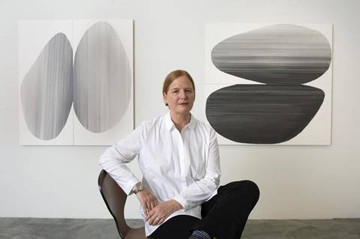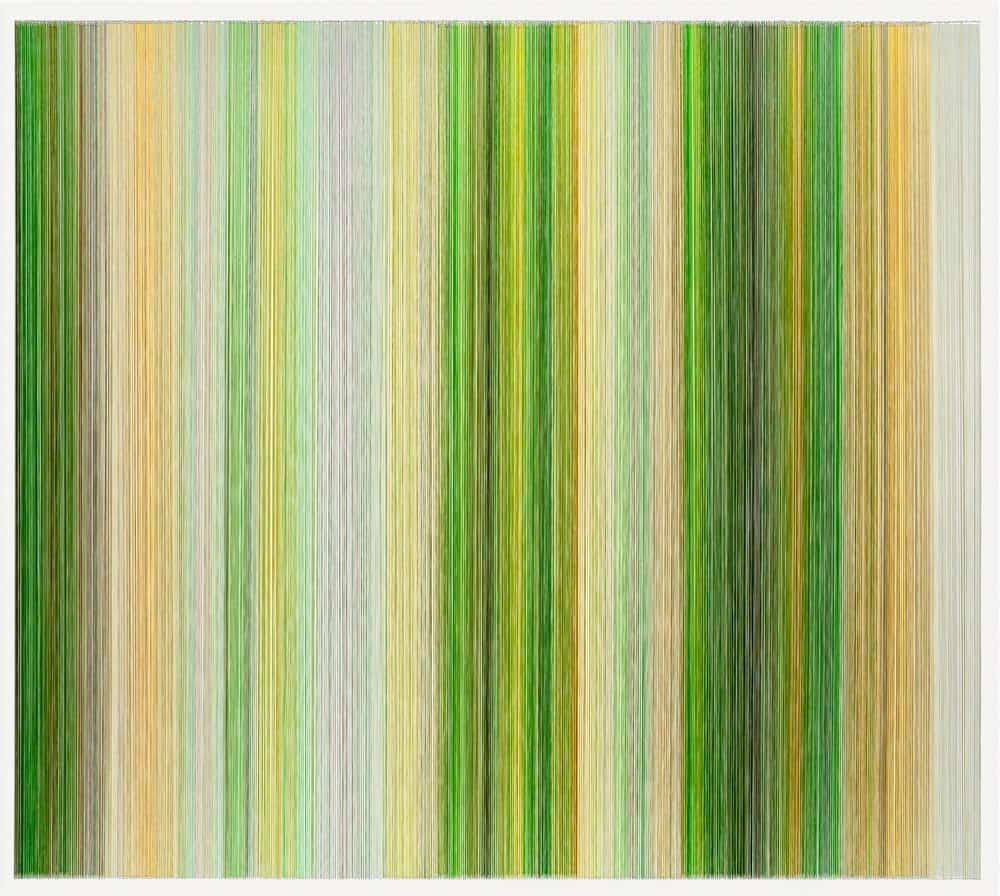Anne Lindberg
I first encountered Anne Lindberg’s work about seven years ago, when she was in residence at the Omi International Art Center in upstate New York, and then a few months later, while she was hanging a show at her gallery in Manhattan. In her Omi studio, she was making intriguing installations from thread, a kind of airy drawing in space, stretching from wall to all and catching the light like skeins of gossamer. When we met up in the city, she described for me the architect-designed “table,” a 10-foot vertical surface with a huge parallel bar attached, she uses to make her big drawings in graphite, employing at that time 17 different leads, from very hard to very soft.
From her years in graduate school in the 1980s to the present, in one way or another, Lindberg has been involved with the language of light and line. She grew up in the heart of the Midwest, Iowa City, where her father was a professor of economic geography and her mother and grandmother were both artists. Though she seemed at first headed for a career in journalism at Miami University in Ohio, she gravitated to classes in art and art history and in 1985-86 worked at the Smithsonian in Washington, DC, as a curatorial assistant in the department of ethnology. “I worked with textiles that had been given to the museum by people who lived in West Africa for most of their lives,” she recalls. Later, as part of her coursework toward her MFA at Cranbrook Academy, she continued studying fiber arts but focused on the possibilities of Indigo dye, which, she says, “has an incredible ability to render light and pattern, to create repeating patterns from dark to light. I was also collaging, stitching on a very large scale, and the work I made for four or five years after that grew out of those experiments.”
After Cranbrook, Lindberg became the slide librarian at the Walker Art Center in Minneapolis, an experience she calls an “on-the-ground education in contemporary art.” When she left the Walker for a temporary teaching gig in Kansas City, she ended up staying for 24 years, refining her vision as an artist and, as she says, “getting the work out there.” If one nurses a conception of Kansas City as a respectable backwater, scarcely an incubator for the arts, Lindberg says it’s a fallacy. “It’s an amazing arts scene with lots of support for not-for-profits, and the Nelson-Atkins Museum is a real force in the city.”
She also met her husband, Derek Porter, in Kansas City. When he accepted a position as a professor of lighting design at Parsons School of Design in New York, the couple embarked on a commuting marriage that lasted ten years. They are now both resettled on property they bought more than a decade ago in the rural town of Ancramdale, NY, a little more than about two hours north of Manhattan, where they built a pair of barnlike buildings including a studio 40 feet from the house. Theirs is a union with many intersecting interests. “He’s trained my eye to look at light in many more ways than I would normally,” she says, “taking into consideration the psychological factors of light. My thread installations are in many ways about light—they bring awareness to the way light moves through space.”
Lindberg has experimented with photography, and has made sculpture and site-specific installations, but drawing remains at the heart of her art. Her most recent series, “Field Drawings,” were directly inspired by the landscape around her in the Hudson Valley. Some, as high or long as ten feet, are made from individual panels, again using different leads from soft to dark. “I’m interested in building drawings that have an architectural presence,” she says. While making the first group of “Field Drawings,” she noticed shapes emerging, like misshapen eggs or large rounded boulders, ambiguous in their form and references. This “Tandem Series” has a seam down the middle and opens a conversation about the relationship between two different entities: How are they related? Is one the shadow of the other? And do they represent some step toward an involvement with more organic forms in Lindberg’s work?
Years ago she told me, “I believe in the potential of one action and one material having many voices, many variations.” And that remains the enduring foundation of her work, tying together light and space, mass and void, and all the subtle gradations in between.
Ann Landi
 Anne Lindberg’s works have been in solo and group exhibitions in New York City, São Paulo, and Norway, and are in the collections of the Detroit Institute of Art, the Kemper Museum of Contemporary Art, the Nevada Museum of Art, as well as many private and corporate collections. She has had shows at the Contemporary Art Center in Cincinnati, the Museum of Fine Arts in Boston, and The Drawing Center in New York. She recently completed a major public art commission for the Richard Bolling Federal Building in Kansas City, MO, and is working on another for Rockhurst University, also in Kansas City. Lindberg is the recipient of numerous awards, including a Joan Mitchell Foundation Grant and a National Endowment for the Arts Fellowship, and shows with Carrie Secrist Gallery in Chicago. More about her can be found at annelindberg.com.
Anne Lindberg’s works have been in solo and group exhibitions in New York City, São Paulo, and Norway, and are in the collections of the Detroit Institute of Art, the Kemper Museum of Contemporary Art, the Nevada Museum of Art, as well as many private and corporate collections. She has had shows at the Contemporary Art Center in Cincinnati, the Museum of Fine Arts in Boston, and The Drawing Center in New York. She recently completed a major public art commission for the Richard Bolling Federal Building in Kansas City, MO, and is working on another for Rockhurst University, also in Kansas City. Lindberg is the recipient of numerous awards, including a Joan Mitchell Foundation Grant and a National Endowment for the Arts Fellowship, and shows with Carrie Secrist Gallery in Chicago. More about her can be found at annelindberg.com.
Photo credits: taut green (2014), cotton thread and staples, 34 by 4 by 20 feet, Contemporary Art Center, Atlanta, GA (photo by Derek Porter); photo of Anne Lindberg by Joe Ledford.


I love how Anne depicts light moving through space. Great article.
Beautiful, thoughtful work… thank you for the article.